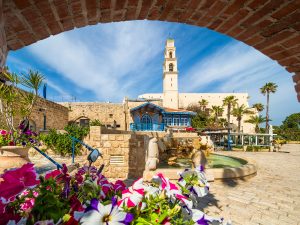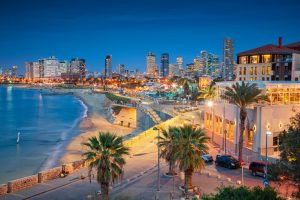Also called “the city that never stops”
The Jewish community of Jaffa grew fivefold after the start of the First Alyah in 1882. Before the end of the century two new neighborhoods were founded: Neve Zedeq and Neve Shalom and several others followed before the Second Alyah began in 1904-1905; this new wave worsened the housing shortage.
In 1906 a group of Jews from Jaffa organized a voluntary Homebuilders Society to build a Jewish garden suburb outside the town. Soon they renamed their group Ahuzat Bayit – “Homestead”. They purchased dunes northeast of Jaffa and divided the terrain in 60 plots.
In 1910 the name was changed to Tel Aviv, meaning “Hill of Spring”. Their immediate inspiration was the title that Nahum Sokolov had given to his Hebrew translation of Herzl’s utopian romance, Alt-neuland. Sokolov who borrowed the name from Ezekiel 3-15, thought of “tel” (a heap of ancient ruins), corresponding to alt (old); and of spring, conveying the idea of reborn talent in neu (new).
The population of Tel Aviv gradually increased, particularly in the late 1920’s.
On May 12th, 1934, Tel Aviv officially received municipal status.
When the state of Israel was proclaimed in the home of the city’s mayor Meir Dizengoff on May 14th, 1948, Tel Aviv was briefly the capital, because Jordan occupied Jerusalem. In 1949 the government was transferred to Jerusalem. In 1950 Tel Aviv and Jaffa were merged and the city adopted the official name Tel Aviv-Yafo.
Today, Tel Aviv is Israel’s second largest city (after Jerusalem) with a population of 360 000 inhabitants. It is also the country’s business and cultural center. To get acquainted with the city walk along the Orange Route. The city has several museums like the Tel Aviv Museum on Sderot Shaul Hamelech, Haim Nahman Bialiks home (Israel’s national Poet) and a small museum devoted to Nahum Gutman, one of Israel’s well-known artists.
David Ben Gurions home has also been transformed into a museum (Sderot Ben Gurion). Ben Gurions library of 20000 volumes remained in tact and is filling much of the upper floor of the house.
On the campus of the Tel Aviv University is the Diaspora Museum – Beit Hatefuthsot. It contains exhibits of the history of the Jewish people.
Moreover, the city that never stops has a lot to offer for people who like to spend evenings and nights in an interesting and special way and who does not like to stay at home or hotel. One of the thing that many single men prefer to do is to spend evening with a beautiful and seductive lady, for such is as Tel Aviv is not a problem at all because there are a lot of opportunities here. The best way to spend an unforgettable evening is to choose one of escort girls who will accompany you to the night club or bar or escort girls in Tel Aviv can simply arrive to your hotel room or where ever you wish.
Jaffa
Jaffa is the oldest of the ports along the coast of Israel. According to an old legend, Jaffa derives its name from Yefet, the name of Noah’s, who settled in the region after the “Flood”. According to a second legend, it gets its name from Jaffa: “The Beautiful”. A third legend tells about Jonah who embarked at the port of Jaffa or Joppa on his way to Tarshish, running away when the Lord commanded him to preach in the wicked city of Nineveh. When a storm threatened to wreck the ship the sailors threw Jonah into the water. He was swallowed by a whale and remained there for three days and three nights (Jonah 1:3-17).
The New Testament records that it was in Jaffa that Simon Peter healed Tabitha the seamstress (Acts9:36-42).
Today Jaffa is a popular tourist destination, because of its restored old quarter filled with galleries, shops and restaurants.
Some places to see in Jaffa:
• The clock square, built in 1906 in honor of
Sultan Abed Al-Hamid II’s 25th anniversary.
• Abulafia in Yeffeth Street is a popular bakery.
• The Andromeda Rock; Andromeda was chained
to that rock when Perseus rescued her.
• The Zodiac Alleys, an abundance of art galleries.
• Jaffa’s Seaport with its restaurants.

